Toilet
 | We have an offline version of our healthcare content. Download the Android app and access all this content when there's no Internet. (other languages) |
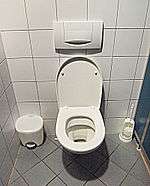
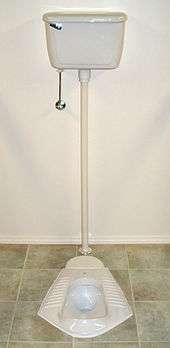
.jpg)
A toilet[n 1] is a sanitation fixture used for the storing or disposal of human urine and feces. In developed countries, different forms of porcelain flush toilets are common: seats are usually used in the West while squat toilets are common in East Asia. These are connected to a sewer system in most urban areas and to septic tanks in less built-up areas. In many developing countries, especially in rural areas, dry toilets such as pit latrines and composting toilets remain common. Dry toilets are usually placed in outhouses, i.e. not inside the dwelling, and are ideally located away from sources of drinking and bathing water.
In many countries, private homes are designed with the flush toilet and the bath or shower in the same room, the bathroom, to simplify plumbing and reduce cost. Other cultures find this insanitary, and have one room for body-washing and a separate room for excretion. Public toilets are installed where their use is expected on a permanent basis, while portable toilets may be brought in for large but temporary gatherings. Chemical toilets are also used in various contexts, such as passenger trains and airplanes.
Serious waterborne diseases such as cholera and diarrhea occur when open defecation or poor sanitation permits human waste to pollute water supplies. Historically, sanitation has been a concern from the earliest stages of human settlements. The Indus Valley Civilization is particularly notable for its extensive sanitation works, including private flush toilets. For the most part, early cities emptied their waste into rivers or seas manually or via open ditches. Sanitation in ancient Rome was notably advanced, as were some of the reredorters of medieval monasteries, but emptying of chamber pots into city streets continued into the modern era. A precursor to the modern flush toilet system was designed by John Harington in 1596 but did not become common until the late 19th century. Even London, at that time the world's largest city, did not require indoor toilets in its building codes until after the First World War.
Types by odor seal
Flush toilets
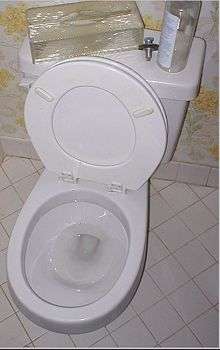
A typical flush toilet is a ceramic bowl (pan) connected on the "up" side to a cistern (tank) that enables rapid filling with water, and on the "down" side to a drain pipe that removes the effluent. When a toilet is flushed, the sewage should flow into a septic tank or into a system connected to a Sewage treatment plant. However, in some countries, this treatment does not happen.
The Plumbing is key. The water in the toilet bowl is connected to a pipe shaped like an upside-down U. One side of the U channel is arranged as a siphon tube longer than the water in the bowl is high. The siphon tube connects to the drain. The bottom of the drain pipe limits the height of the water in the bowl before it flows down the drain. The water in the bowl acts as a barrier to sewer gas entering. Sewer gas escapes through a vent pipe attached to the sewer line.
The amount of water used by conventional flush toilets usually makes up a significant portion of personal daily water usage. However, modern low flush toilet designs allow the use of much less water per flush. Dual flush toilets allow the user to select between a flush for urine or feces, saving a significant amount of water over conventional units. The flush handle on these toilets is pushed up for one kind of flush and down for the other.[1] In some places, users are encouraged not to flush after urination. Flush toilets can be plumbed to use Greywater (previously used for washing dishes, laundry and bathing) rather than Potable water (drinking water). Some modern toilets pressurize the water in the tank, which initiates flushing action with less water usage.
Flush toilets, when used on ships, are typically flushed with seawater. Another variant is the pour-flush,[2] flush toilets lacking a cistern, which are flushed manually with a few litres of a small bucket. This type of low-cost toilet is common in many Asian countries. It can use as little as 2-3 litres, and this can be greywater or rainwater.[2][3]
Dry toilets
Many different types of dry toilets exist. For example, from simple to more complex: a bucket toilet (honey bucket), a tree bog or arborloo (two simple systems for converting excrement to direct fertiliser for trees), a pit toilet (a deep hole in the ground), a vault toilet (which keeps all the waste underground until it is pumped out), a composting toilet (which mixes excreta with carbon-rich materials for faster decomposition), a urine-diverting dry toilet (which keeps urine separate from feces), and the self-explanatory incinerating and freezing toilets. Dry toilets use no, or very little, water; they do not depend on flushing, and so do not produce Wastewater. Some of these devices are high-tech, all the way to the space toilet on the International Space Station, but many are extremely basic; hundreds of thousands of Indian people are still employed as manual scavengers in emptying buckets and pit latrines.[4][5][6]
Pit latrine
.jpg)
A pit toilet, or pit latrine, is a dry toilet system which collects human excrement in a pit or trench, ranging from a simple slit trench to more elaborate systems with seating or squatting pans and ventilation systems. In developed countries they are associated with camping and wilderness areas, whereas they are common in rural or peri-urban areas of much of the developing world. Pit toilets are used in emergency situations.
The waste pit or trench can be dug large enough that the reduction in mass of the contained waste products by the ongoing process of decomposition allows the pit to be used for many years before it fills up. When the pit becomes too full, it may be emptied or the hole covered with earth. Pit latrines have to be located away from drinking water sources (wells, streams, etc.) to minimize the possibility of disease spread via groundwater pollution.
Army units typically use a form of pit toilet when they are in the field and away from functional sewerage systems. Correctly located pit toilets were found to prevent spread of various diseases; diseases which would kill many more soldiers than those killed via bullets and artillery used in pre-1940 warfare.[7]
Vault toilet
A vault toilet is a non-flush toilet with a sealed container buried in the ground to receive the waste, all of which is contained underground until it is purposely removed by pumping. A vault toilet is distinguished from a pit toilet because the waste accumulates in the vault instead of seeping into the underlying soil. A vault toilet has similarities to a septic tank.
Urine diversion toilets
Urine diversion toilets have two compartments, one for urine and one for feces. One or both compartment may be flushed with water. A Urine-diverting dry toilet can be linked to systems which reuse excreta as a fertilizer or biofuel. Astronauts use a UDDT type of space toilet to recover potable water.[8]
Others
Portable toilets

The portable toilet is used on construction sites, film locations, and large outdoor gatherings where there are no other facilities. They are typically self-contained units that are made to be easily moved. Most portable toilets are Unisex single units with privacy ensured by a simple lock on the door. The units are usually light weight and easily transported by a flatbed truck and loaded and unloaded by a small forklift. Many portable toilets are small molded plastic or fiberglass portable rooms with a lockable door and a receptacle to catch waste in a chemically treated container. If used for an extended period of time, they have to be cleaned out and new chemicals put in the waste receptacle. For servicing multiple portable toilets, tanker trucks (vacuum trucks or honeywagons) are equipped with large vacuums to evacuate the waste and replace the chemicals. Portable toilets can also be urine-diverting dry toilets.
A bucket toilet, also known as a honey bucket, is a very simple type of portable toilet.
Chemical toilets
Chemical toilets which do not require a connection to a water supply are used in a variety of situations. Examples include passenger train toilets and airplane toilets and also complicated space toilets for use in zero-gravity spacecraft.
Flying toilets
The unsanitary "flying toilets" are used in African informal settlements where plastic shopping bags are used as a container for excrement and are then simply discarded. They are called flying toilets "because when you have filled them, you throw them as far away as you can."[9] This practice, coupled with the solid waste problem of discarded plastic bags, has led to the banning of the manufacture and import of such bags in Uganda, Kenya, and Tanzania.[9]
High-tech toilets
"High-tech" toilets include features such as: automatic-flushing mechanisms that flush a toilet or urinal when finished; water jets, or "bottom washers" like a bidet; blow dryers; artificial flush sounds to mask noises; and urine and stool analysis for medical monitoring. Matsushita's "Smart Toilet" checks blood pressure, temperature, and blood sugar. Some feature automatic lid operation, heated seats, deodorizing fans or automated paper toilet-seat-cover replacers. Interactive urinals have been developed in several countries, allowing users to play video games as with the "Toylet", produced by Sega, that uses pressure sensors to detect the flow of urine and translates it into on-screen action.[10]
Floating toilets
A floating toilet is essentially an toilet on a platform built above or floating on the water. Instead of excreta going into the ground they are collected in a tank or barrel. To reduce the amount of excreta that needs to hauled to shore, many use Urine diversion. The floating toilet was developed for residents without quick access to land or connection to a sewer systems.[11] It is also used in areas subjected to prolonged flooding.[12] The need for this type of toilet is high in areas like Cambodia.[13]
Toilets connected to livestock or aquaculture
For thousands of years, humans have used the ability of certain animals to thrive on a diet of our excreta. With modern sanitation knowledge, the disease risk posed by these livestock toilets has been recognised, but nonetheless they continue to serve a function in the lives of peasants. The Pig toilet, which consists of a toilet linked to a Pigsty by a chute, is still in use to a limited extent.[14] It was common in rural China, and was known in Japan, Korea, and India. The "Fish pond toilet" depends on the same principle, of livestock (often carp) eating human excreta directly. In China, "Family dwellings are commonly built close to the fish pond with toilets overhanging the pond to facilitate fertilization. [...] Some pigsties as well as latrines for humans are built on the adjacent dike so as to overhang the pond." But by 1988, these fish pond toilets were falling out of favour, as the farmers found it more useful to ferment human and pig excrement together, and apply it to the Aquaculture ponds as needed.[15]
In Vietnam, the traditional fish pond toilet, which was described as "widespread" as recently as 2008, polluted the waterways but was perceived as more hygenic (less smelly) than various modern alternatives that the government was pressing on the villagers.[16]
Types by usage posture
Toilets can be designed to be used either in a sitting or in a squatting posture.
Squat toilets
A squat toilet (also called "squatting toilet", "natural position toilet", or by many national names) is a toilet of any technology type (i.e. pit latrine, urine-diverting dry toilet, flush toilet etc.) which is used in a Squatting position rather than sitting. This means that the Defecation posture used is to place one foot on each side of the toilet drain or hole and to squat over it.
Squatting toilets are the norm in many Asian and African countries, but can also occasionally be found in some European and South American countries. They are common in most Muslim countries. They can be used in conjunction with anal cleansing with water in accordance with Islamic toilet etiquette.
In 1976, squatting toilets were said to be used by the majority of the world's population.[17] However, there is a general trend in many countries to move from squatting toilets to sitting toilets (particularly in urban areas) as the latter are often regarded as more modern.[18]
|
Usage
Urination
There are cultural differences in socially accepted and preferred voiding positions for urination around the world: in the Middle-East and Asia, the squatting position is more prevalent, while in the Western world the standing and sitting position are more common.[19]
Anal cleansing habits
In the Western world, the most common method of cleaning the anal area after defecation is by toilet paper or sometimes by using a bidet. In many Muslim countries, the faciliites are designed to enable people to follow Islamic toilet etiquette Qaḍāʼ al-Ḥājah.[20] For example, a bidet shower may be plumbed in. The left hand is used for cleansing, for which reason that hand is considered impolite or polluted in many Asian countries.[21] Japanese toilet technology has created the washlet, a registered trademark referring to electric toilet seats with water spray feature for anal and genital cleansing.
Public toilets
A public toilet is accessible to the general public. It may be municipally owned or managed, entered directly from the street. It may be within a building that, while privately owned, allows public access, such as a department store, or it may be limited to the business's customers, such as a restaurant. If its use requires a fee, it is also called a pay toilet.
Depending on culture, there may be varying degrees of separation between men and women and different levels of privacy. Typically, the entire room, or a stall or cubicle containing a toilet, is lockable. Urinals, if present in a men's toilet, are typically mounted on a wall with or without a divider between them. In the most basic form, a public toilet may be not much more than an open latrine. Another form is a street urinal known as a pissoir, after the French term.
Public health aspects

To this day, 1 billion people in developing countries have no toilets in their homes and are resorting to Open defecation instead.[22] The Joint Monitoring Programme (JMP) for Water Supply and Sanitation by WHO and UNICEF is the official United Nations mechanism tasked with monitoring progress towards the Millennium Development Goal relating to drinking-water and sanitation (MDG 7, Target 7c). One target of this goal is to: "Halve, by 2015, the proportion of people without sustainable access to safe drinking-water and basic sanitation" and publishes figures on access to sanitation worldwide on a regular basis.[23] Another organisation which focuses on toilet and sanitation is the World Toilet Organisation which has its founding date, November 19, used for the UN's International World Toilet Day.[24]
Toilets are one important element of a sanitation system, although other elements are also needed: transport, treatment, disposal or reuse.[2] Diseases, including Cholera, which still affects some 3 million people each year, can be largely prevented when effective sanitation and water treatment prevents fecal matter from contaminating waterways, groundwater and drinking water supplies.
Example of cholera in England
There have been five main Cholera outbreaks and pandemics since 1825. In London alone, the second killed 14,137 people in 1849, and the third took 10,738 lives in 1853-54. In 1849 the English physician John Snow published a paper On the Mode of Communication of Cholera, in which he suggested that cholera might be waterborne. During the 1854 epidemic, he collected and analyzed data establishing that people who drank water from contaminated sources such as the Broad Street pump died of cholera at much higher rates than those who got water elsewhere.
History
Ancient history
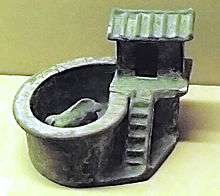
During the third millennium BC, toilets and sewers were invented throughout the world. Mohenjo-Daro circa 2800 BC is cited as having some of the most advanced, with toilets built into outer walls of homes. These toilets were Western-style, albeit a primitive form, with vertical chutes, via which waste was disposed of into cesspits or street drains.[25]
These toilets were only used by the affluent classes; most people would have squatted over old pots set into the ground or used open pits.[26] The people of the Harappan civilization in Pakistan and northwestern India had primitive water-cleaning toilets that used flowing water in each house that were linked with drains covered with burnt clay bricks. The flowing water removed the Human waste.[27] The Indus Valley civilisation had a rudimentary network of sewers built under grid pattern streets.[28]
Other very early toilets that used flowing water to remove the waste are found at Skara Brae in Orkney, Scotland, which was occupied from about 3100 BC until 2500 BC. Some of the houses there have a drain running directly beneath them, and some of these had a cubicle over the drain. Around the 18th century BC, toilets started to appear in Minoan Crete, Pharaonic Egypt, and ancient Persia.
In 2012, archaeologists founded what is believed to be Southeast Asia's earliest latrine during the excavation of a neolithic village in the Rạch Núi archaeological site, southern Vietnam. The toilet, dating back 1500 BC, yielded important clues about early Southeast Asian society. More than 30 coprolites, containing fish and shattered animal bones, provided information on the diet of humans and dogs, and on the types of parasites each had to contend with.[29][30][31]
In Roman civilization, toilets using flowing water were sometimes part of public bath houses. Roman toilets, like the ones pictured here, are commonly thought to have been used in the sitting position. The Roman toilets were probably elevated to raise them above open sewers which were periodically "flushed" with flowing water, rather than elevated for sitting. Romans and Greeks also used chamber pots, which they brought to meals and drinking sessions.[32] Johan J. Mattelaer said, "Plinius has described how there were large receptacles in the streets of cities such as Rome and Pompeii into which chamber pots of urine were emptied. The urine was then collected by fullers." (Fulling was a vital step in Textile manufacture.)
The Han dynasty in China two thousand years ago used pig toilets.
Post-classical history
Garderobes were toilets used in the Post-classical history, most commonly found in upper-class dwellings. Essentially, they were flat pieces of wood or stone spanning from one wall to the other, with one or more holes to sit on. These were above chutes or pipes that discharged outside the castle or Manor house.[33] Garderobes would be placed in areas away from bedrooms to shun the smell[34] and also near kitchens or fireplaces to keep the enclosure warm.[33]
|
The other main way of handling toilet needs was the chamber pot, a receptacle, usually of ceramic or metal, into which one would excrete waste. This method was used for hundreds of years; shapes, sizes, and decorative variations changed throughout the centuries.[35] Chamber pots were in common use in Europe from ancient times, even being taken to the Middle East by medieval pilgrims.[36]
Modern history
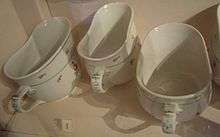

By the Early Modern era, chamber pots were frequently made of china or copper and could include elaborate decoration. They were emptied into the gutter of the street nearest to the home.
By the 16th century, cesspits and cesspools were increasingly dug into the ground near houses in Europe as a means of collecting waste, as urban populations grew and street gutters became blocked with the larger volume of human waste. Rain was no longer sufficient to wash away waste from the gutters. A pipe connected the latrine to the cesspool, and sometimes a small amount of water washed waste through. Cesspools were cleaned out by tradesmen, who pumped out liquid waste, then shovelled out the solid waste and collected it during the night. This solid waste, euphemistically known as Nightsoil, was sold as fertilizer for agricultural production (similarly to the closing-the-loop approach of ecological sanitation).
The garderobe was replaced by the Privy midden and Pail closet in early industrial Europe.
In the early 19th century, public officials and public hygiene experts studied and debated sanitation for several decades. The construction of an underground network of pipes to carry away solid and liquid waste was only begun in the mid 19th-century, gradually replacing the cesspool system, although cesspools were still in use in some parts of Paris into the 20th century.[37]
Before the introduction of indoor toilets, it was common to use the chamber pot under one's bed at night and then to dispose of its contents in the morning. During the Victorian era, British housemaids collected all of the household's chamber pots and carried them to a room known as the housemaids' cupboard. This room contained a "slop sink", made of wood with a lead lining to prevent chipping china chamber pots, for washing the "bedroom ware" or "chamber utensils". Once running water and flush toilets were plumbed into British houses, servants were sometimes given their own lavatory downstairs, separate from the family lavatory.[38] The practice of emptying one's own chamber pot, known as Slopping out, continued in British prisons until recently and is still in use in the Republic of Ireland.
With rare exceptions, chamber pots are no longer used. Modern related implements are bedpans and commodes, used in hospitals and the homes of invalids.
Development of dry earth closets

Before the flush toilet became as popular as it is, there were inventors, scientists, and public health officials in Europe who supported the use of "dry earth closets". One person developing these was the English clergyman Henry Moule, who dedicated his life to improving public sanitation after witnessing the horrors of the cholera epidemics of 1849 and 1854. He invented what he called the dry earth system, somewhat similar to a composting toilet or a bucket toilet. In partnership with James Bannehr, in 1860 he took out a patent for the process (No. 1316).
His system was adopted in private houses, in rural districts, in military camps, in many hospitals, and extensively in the British Raj. Ultimately, however, it failed to gain the same public support in Europe as the water closet, although variations of the design remain today in use (see dry toilet).
Development of flush toilets
Although a precursor to the flush toilet system which is widely used nowadays was designed in 1596 by John Harington,[39] such systems did not come into widespread use until the late nineteenth century.[40] With the onset of the industrial revolution and related advances in technology, the flush toilet began to emerge into its modern form. A crucial advance in plumbing, was the S-trap, invented by the Scottish mechanic Alexander Cummings in 1775, and still in use today. This device uses the standing water to seal the outlet of the bowl, preventing the escape of foul air from the sewer. It was only in the mid-19th century, with growing levels of urbanisation and industrial prosperity, that the flush toilet became a widely used and marketed invention. This period coincided with the dramatic growth in the sewage system, especially in London, which made the flush toilet particularly attractive for health and sanitation reasons.
Flush toilets were also known as "water closets", as opposed to the earth closets described above. WCs first appeared in Britain in the 1880s, and soon spread to Continental Europe. In America, the chain-pull indoor toilet was introduced in the homes of the wealthy and in hotels in the 1890s. William Elvis Sloan invented the Flushometer in 1906, which used pressurized water directly from the supply line for faster recycle time between flushes.
Names
Etymology
_with_her_Two_Eldest_Sons_-_Google_Art_Project_(cropped).jpg)
Toilet was originally a French loanword (first attested in 1540) that referred to the toilette ("little cloth") draped over one's shoulders during hairdressing.[42] During the late 17th century,[42] the term came to be used by metonymy in both languages for the whole complex of grooming and body care that centered at a dressing table (also covered by a cloth) and for the equipment composing a toilet service, including a mirror, hairbrushes, and containers for powder and makeup. The time spent at such a table also came to be known as one's "toilet"; it came to be a period during which close friends or tradesmen were received as "toilet-calls".[42][43]
The use of "toilet" to describe a special room for grooming came much later (first attested in 1819), following the French cabinet de toilet. Similar to "powder room", "toilet" then came to be used as a euphemism for rooms dedicated to urination and defecation, particularly in the context of signs for public toilets, as on trains. Finally, it came to be used for the plumbing fixtures in such rooms (apparently first in the United States) as these replaced chamber pots, outhouses, and latrines. These two uses, the fixture and the room, completely supplanted the other senses of the word during the 20th century[42] except in the form "toiletries".[n 2]
Contemporary Use
The word "toilet", for the plumbing fixture or for the room, is considered impolite in some varieties of English, while elsewhere the word is used without any embarrassment. "Toilet" was by etymology a euphemism, but is no longer understood as such. As old euphemisms have become the standard term, they have been progressively replaced by newer ones, an example of the euphemism treadmill at work.[46] The choice of word relies not only on regional variation, but also on social situation and level of formality (register) or social class. American manufacturers show an uneasiness with the word and its class attributes: American Standard, the largest firm, sells them as "toilets", yet the higher priced products of the Kohler Company, often installed in more expensive housing, are sold as commodes or closets, words which also carry other meanings. Confusingly, products imported from Japan such as TOTO are referred to as "toilets", even though they carry the cachet of higher cost and quality. (Toto, an abbreviation of Tōyō Tōki (東洋陶器 Oriental Ceramics), is used in Japanese comics to visually indicate toilets or other things that look like toilets; see Toilets in Japan.)
Regional Variants
Different dialects use "bathroom" and "restroom" (American English), "bathroom" and "washroom" (Canadian English), and "WC" (an initialism for "water closet"), "lavatory" and its abbreviation "lav" (British English).
Euphemisms
Crapper - Crapper was already in use as a coarse name for a toilet, but it gained currency from the work of Thomas Crapper, who popularized flush toilets in England.
The Jacks is Irish slang for toilet.[47] It perhaps derives from "jacques" and "jakes", an old English term.[48]
Loo - The etymology of loo is obscure. The Oxford English Dictionary notes the 1922 appearance of "How much cost? Waterloo. Watercloset." in James Joyce's novel Ulysses and defers to Alan S. C. Ross's arguments that it derived in some fashion from the site of Napoleon's 1815 defeat.[49][50] In the 1950s the use of the word "loo" was considered one of the markers of British upper-class speech, featuring in a famous essay, "U and non-U English".[51] "Loo" may have derived from a corruption of French l'eau ("water"), gare à l'eau ("mind the water", used in reference to emptying chamber pots into the street from an upper-story window), lieu ("place"), lieu d'aisance ("place of ease", used euphemistically for a toilet), or lieu à l'anglaise ("English place", used from around 1770 to refer to English-style toilets installed for travelers).[49][52][53] Other proposed etymologies include a supposed tendency to place toilets in room 100 (hence "loo") in English hotels,[54] a dialectical corruption of the nautical term "lee" in reference to the need to urinate and defecate with the wind prior to the advent of head pumps,[n 3] or the 17th-century preacher Louis Bourdaloue, whose long sermons at Paris's Saint-Paul-Saint-Louis prompted his parishioners to bring along chamber pots.[55]
Gallery
|
See also
| Wikivoyage has travel information for Toilets. |
| Wikimedia Commons has media related to Toilet. |
Notes
- ↑ For a full list of English synonyms, see "toilet" at Wikisaurus.
- ↑ The French eau de toilette ("toilet water") is sometimes used as a sophisticated synonym for perfume and cologne but is generally received jokingly, as with Cosmopolitan's parody "If it doesn't say 'eau de toilette' on the label, it most likely doesn't come from the famed region of Eau de Toilette in France and might not even come from toilets at all."
- ↑ Yachtsmen still tend to refer to their toilets as "loos" rather than "heads".
References
- ↑ "Tucson lawmaker wants tax credits for water-conserving toilet". Cronkite News Service. Retrieved 2008-03-12.
- 1 2 3 Tilley, E., Ulrich, L., Lüthi, C., Reymond, Ph., Zurbrügg, C. Compendium of Sanitation Systems and Technologies - (2nd Revised Edition). Swiss Federal Institute of Aquatic Science and Technology (Eawag), Duebendorf, Switzerland. ISBN 978-3-906484-57-0.
- ↑ "Pour Flush Toilet". Akvo. Retrieved 21 May 2016.
- ↑ "Swachh Bharat Abhiyan should aim to stamp out manual scavenging".
- ↑ Umesh IsalkarUmesh Isalkar, TNN (30 April 2013). "Census raises stink over manual scavenging". The Times of India. Retrieved 6 September 2015.
- ↑ "Manual scavenging still a reality". The Hindu. 9 July 2015. Retrieved 9 September 2015.
- ↑ "Fabrication of Semi Automated Pressurized Flushing System in Indian Railway Toilet". International Journal of Engineering and Advanced Technology (IJEAT). February 2013. Retrieved 17 July 2016.
- ↑ NASA Gives Space Station Crew 'Go' to Drink Recycled Water, May 2009
- 1 2 Whitaker, Mark. 30 June 2007. "Why Uganda hates the plastic bag." BBC News via news.bbc.co.uk. Retrieved on 28 September 2007.
- ↑ Geere, Duncan. (6 January 2011). "'Toylet' Games in Japan's Urinals". Wired UK. Retrieved 20 January 2011.
- ↑ Sample Designs: Floating UDD Toilets, Asian Development Bank Website
- ↑ Article, Govt: Bt900bn needed (in Thailand), The Nation October 31, 2011
- ↑ Article: Floating toilets to clean up Cambodia's act, Author: Geoffrey Cain April 19, 2010, Global Post
- ↑ Environmental History of Water, p.40
- ↑ Kenneth Ruddle, Gongfu Zhong (1988). Integrated Agriculture-Aquaculture in South China: The Dike-Pond System of the Zhujiang Delta. Cambridge. p. 173.
- ↑ Mader, Philip (12 January 2016). The Political Economy of Microfinance: Financializing Poverty. Springer. p. 144.
- ↑ Kira A. The Bathroom. Harmondsworth: Penguin, 1976, revised edition, pp.115,116.
- ↑ von Münch, E.; Milosevic, D. (2015): Qualitative survey on squatting toilets and anal cleansing with water with a special emphasis on Muslim and Buddhist countries by using the SuSanA discussion forum. Ostella Consulting, Schwalbach, Germany
- ↑ Y. de Jong. "Influence of voiding posture on urodynamic parameters in men: a literature review (in Dutch)" (PDF). Nederlands Tijdschrift voor urologie. Retrieved 2014-07-02.
- ↑ Shu'aib, Tajuddin B., "Qadaahul Haajah (Relieving Oneself)", The Prescribed Prayer Made Simple, MSA West Compendium of Muslim Texts, retrieved 2009-03-10
- ↑ "Eight surprisingly rude gestures to avoid when travelling". News.com.au. November 21, 2013. Retrieved 17 July 2016.
- ↑ manic. "World Toilet". World Toilet. Retrieved 2016-03-07.
- ↑ WHO and UNICEF Progress on Sanitation and Drinking-water: 2013 Update, WHO, Geneva and UNICEF, New York
- ↑ manic. "World Toilet". World Toilet. Retrieved 2016-03-07.
- ↑ Teresi et al. 2002
- ↑ "Early Latrines and Plumbing". Retrieved 30 May 2015.
- ↑ Who invented a version of the flowing water toilet
- ↑ "The History of the Toilet". Thomas Mulrooney. Retrieved 19 September 2013.
- ↑ Old toilet find offers civilization start clues. Stuff.co.nz. Retrieved 28 September 2013.
- ↑ Time capsule. Viet Nam News. Retrieved 28 September 2013.
- ↑ Asia’s First Toilet Discovered In Southern Viet Nam. Asian Scientist. Retrieved 28 September 2013.
- ↑ Mattelaer, Johan J. "Some Historical Aspects of Urinals and Urine Receptacles." World Journal of Urology 17.3 (1999): 145-50. Print.
- 1 2 Genc, Melda. "The Evolution of Toilets and Its Current State." Thesis. Middle East Technical University, 2009. Harold B. Lee Library. Brigham Young University, 2009. Web. 28 Nov. 2011.
- ↑ "Middle Ages Hygiene." Middle Ages. The Middle Ages Website. Web. 28 Nov. 2011.
- ↑ Powell, Christine A. "Port Royal Chamberpots Introduction." Nautical Archaeology at Texas A&M University. Texas A&M University, 1 Dec. 1996. Web. 28 Nov. 2011.
- ↑ Setton, Kenneth M. & Harry W. Hazard (1977). A History of the Crusades, Volume IV: The Art and Architecture of the Crusader States. University of Wisconsin Press. p. 47. ISBN 978-0-299-06824-0.
- ↑ La Berge, Ann Elizabeth Fowler (2002). Mission and Method: The Early Nineteenth-Century French Public Health Movement. Cambridge University Press. pp. 207–9. ISBN 978-0-521-52701-9.
- ↑ Flanders, Judith (2003). The Victorian House. London: HarperCollins. p. 64. ISBN 0-00-713189-5.
- ↑ "Victoriancrapper.com". Retrieved 30 May 2015.
- ↑ Poop Culture: How America is Shaped by its Grossest National Product, Dave Praeger, ISBN 1-932595-21-X
- ↑ See Egerton op cit
- 1 2 3 4 "toilet, n.", Oxford English Dictionary, Oxford: Oxford University Press.
- ↑ See, e.g., the description of the Hogarth painting "The Toilette" from his Marriage à-la-mode series in Egerton[44] or the extensive discussion of a lady's toilet in Pope.[45]
- ↑ Egerton, Judy (1998), "The British School", National Gallery Catalogues, New Series, p. 167, ISBN 1-85709-170-1.
- ↑ Pope, Alexander (1717), The Rape of the Lock.
- ↑ "The honest Jakes or Privy has graduated via Offices to the final horror of Toilet" - Vicar Bell,
- ↑ "BBC h2g2". Retrieved 25 June 2013.
- ↑ "Toilet Inspector". Retrieved 25 June 2013.
- 1 2 "loo, n.⁴", Oxford English Dictionary.
- ↑ Ross, Alan S.C. (October 1974), Blackwood's Magazine, pp. 309–316.
- ↑ Ross, Alan S.C. (1954), "Linguistic Class-Indicators in Present-Day English", Neuphilologische Mitteilungen, Vol. 55, Helsinki, pp. 113–149.
- ↑ Ashenburg, p. 138.
- ↑ Harper, Douglas. "loo". Online Etymology Dictionary..
- ↑ "Why do they call it the loo?", Kottke, 16 February 2005, retrieved 1 August 2015.
- ↑ "Chamber Pots". Muzeum historických nočníků a toalet. Retrieved 17 July 2016.
Further reading
- Shaw, R. A Collection of Contemporary Toilet Designs. EOOS and WEDC, Loughborough University, UK. p. 40. ISBN 978 1 84380 155 9.
- The Hidden Room A Short History of the ‘Privy’ by Johnny Ragland
- The Dirt on Clean: An Unsanitized History. Katherine Ashenburg. Alfred A. Knopf Canada, Toronto 2007. ISBN 978-0-676-97663-2.
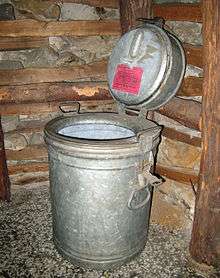





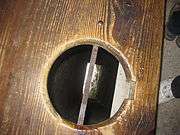




_(4270556587).jpg)